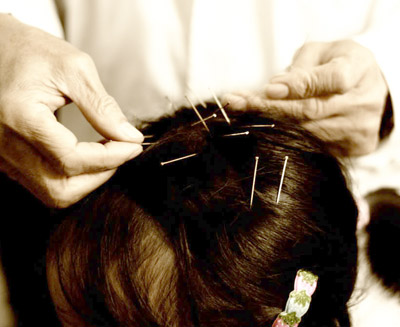Chinese scalp acupuncture is used as an effective treatment for many neurological conditions. It is mainly known for the treatment of stroke patients, studies show how it can effectively improve the quality of life for a post-stroke patient, bringing sensation back to paralysed limbs and improving speech, hearing and balance problems. Scalp acupuncture areas are frequently used in the rehabilitation of stroke, multiple sclerosis, brain injuries, and Parkinson’s disease. It is very effective for pain management, especially pain caused by the central nervous system such as phantom limb pain, complex regional pain and residual limb pain. There are also research studies showing it’s effectiveness in treating aphasia, loss of balance, loss of hearing, dizziness and vertigo.

The location of scalp acupuncture areas are based on the reflex somatotopic system organised in the surface of the scalp in Western Medicine, it is very much linked to brain anatomy and not to the traditional cheese medicine system of channels and points. An understanding and study of brain anatomy are required for the practice of scalp acupuncture. This type of acupuncture consists of needling areas rather than points on the skull according to the brain neuroanatomy and neurophysiology. Scalp acupuncture needles are subcutaneously inserted into whole sections of various zones, unlike the single point insertion of traditional acupuncture. These zones are specific areas through which the function of the nervous and endocrine systems are transported to and from the surface of the scalp. These zones correspond to the cortical areas of the cerebrum and cerebellum responsible for central nervous system functions such as motor activity, sensory input, vision, speech, hearing and balance. The scalp somatotopic system seems to operate as a miniature transmitter-receiver in direct contact with the central nervous and endocrine systems. By stimulating these reflex areas, acupuncture can have direct effects on the cerebral cortex, cerebellum, thalamus cortical circuits, thalamus, hypothalamus and pineal body. Scalp acupuncture treats and prevents disease through the insertion of fine needles into the appropriate scalp areas. These needles are then manipulated to regulate and harmonise the functional activities of the brain and body. It integrates ancient Chinese needling techniques with western neurology.
Paralysis is one of the main conditions treated by scalp acupuncture.
Paralysis is a loss of muscle strength and voluntary movement. It is usually caused by damage to the nervous system, especially the brain and spinal cord. This can be due to stroke, trauma with nerve injury, poliomyelitis, sclerosis, botulism, spina bifida and multiple sclerosis. Even conditions with minor paralysis and associated sensations such as numbness and tingling caused by nerve impingement respond well to scalp acupuncture in the appropriate zones. Stroke is an acute neurological disease in which blood supply to the brain is interrupted causing brain cells to die and be damaged, impairing brain functions. In the treatment of paralysis and stroke scalp and body acupuncture is most effective if started as soon after the incident as possible, although “it is never too late to treat a paralysed patient with scalp acupuncture”. However, when treating haemorrhagic stroke, scalp acupuncture should not be performed until the patient’s condition is stable, about one month after the stroke. Stroke from thrombosis or embolism should be treated as soon as possible. Dysphagia is difficulty swallowing. This can affect all age groups but is more common in the elderly. It can be caused by stroke, multiple sclerosis, Parkinson’s, myasthenia gravis and Bell’s palsy. This condition can respond well to scalp acupuncture.
Multiple sclerosis is a progressive disease of the nervous system, where communication between the brain and other parts of the body is disrupted. Common symptoms of MS are numbness, tingling, weakness in one or more limbs, visual disturbance, tremor, unsteady gait, fatigue, muscle stiffness and spasticity. A combination of scalp and body acupuncture, depending on the prevalent symptoms is the best course of treatment. Spinal cord injuries, often caused by car or sporting injuries. Common symptoms include arm and leg paralysis and weakness, difficulty breathing, tingling, numbness, pain. As for MS, the most effective treatment is a combination of body and scalp acupuncture.
Bell’s Palsy is the paralysis and weakness of one side of the facial muscles caused by a viral attack to the facial nerves. Most patients with Bell’s palsy recover quite quickly but some strains of the virus cause more extensive nerve damage and result in longer periods of paralysis and weakness. Combing facial electro-acupuncture with scalp acupuncture can speed recovery and prevent a long-term problem. This is also the same in the treatment of post-hepatic neuralgia.
Scalp acupuncture is also very effective in treating many pain conditions such as phantom limb pain, complex regional pain, residual limb pain, plantar fasciitis, restless leg syndrome, fibromyalgia, shingles and post hepatic neuralgia, lower back and other musculoskeletal pains.
It can be used in the treatment of sense organ disorders such as Menieres syndrome, tinnitus, hearing loss and vision loss.
It is also very helpful in some complex paediatric disorders such as Attention deficit hyperactivity disorder (ADHD) and bed wetting.
Scalp acupuncture can be beneficial in other neuropsychological disorders such as Post-traumatic stress disorder, Parkinson’s, essential tremor and chronic fatigue syndrome.
In conclusion, scalp acupuncture is a very useful tool for the treatment of many neurological and pain conditions, especially in combination with body acupuncture.
